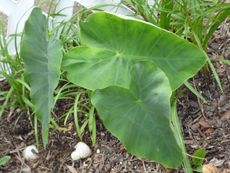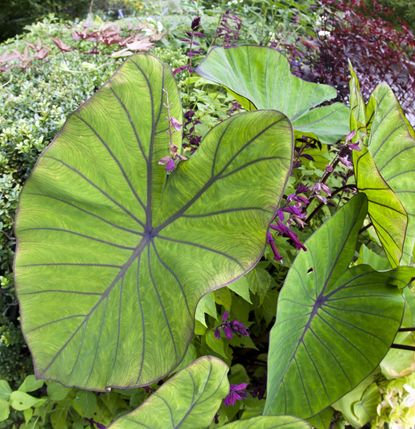Elephant Ear
Your ultimate guide to Elephant Ear: Everything you need to know with expert info for beginners and advanced gardeners alike.
-

Guide To Growing An Elephant Ear Plant Indoors
An elephant ear plant indoors? Create a dramatic indoor focal point in a large room with this mega-leaf tropical plant. You can grow it as a houseplant if you give it warmth and light.
By Amy Grant
-

Elephant Ear Plants: Complete Care And Growing Guide
The large floppy leaves of elephant ear plants are a great tropical touch in a garden where the soil is rich and water is plentiful.
By Nikki Tilley
-

Elephant Ear Problems: What To Do With Elephant Ears Taking Over Garden
Do elephant ears affect nearby plants? There are no allelopathic properties in the corms, but this can be an invasive plant and the excessive size may pose problems for species that live under the giant foliage. Learn more in this article.
By Bonnie L. Grant
-

Elephant Ear Plant Disease In Gardens: How To Treat Sick Elephant Ears
Elephant ears are often grown for their huge, robust foliage. The leaves are prone to several diseases which mar this ornamental appeal. There are also diseases that can cause crown and root rot. If your plant has disease symptoms, this article can help.
By Bonnie L. Grant
-

Dividing Elephant Ears: How And When To Divide Elephant Ears
Elephant ear division is useful to prevent overcrowding, produce more plants in a different location, and enhance plant health. It is important to know when to divide elephant ears to avoid plant injury or poor performance. This article will help.
By Bonnie L. Grant
-

Uses Of Dasheen Plants: Learn About Growing Dasheen Taro Plants
You probably have already heard of dasheen, just with a different name: taro. Check out this article for interesting dasheen plant info including what is dasheen good for and how to grow dasheen. Click here for more.
By Amy Grant
-

Can You Grow Taro In A Pot – Container Grown Taro Care Guide
Taro is a water plant, but you don’t need a pond or wetlands in your backyard to grow it. You can successfully grow taro in containers if you do it right. Click here and learn how to grow this plant in containers so you can enjoy the pretty tropical wherever you are.
By Mary Ellen Ellis
-

Growing Taro For Food: How To Grow And Harvest Taro Root
Another healthier option to the standard potato chip would be growing and harvesting your own taro roots and then turning them into chips. Want to find out how to grow and harvest taro in your own garden? This article will help get you started.
By Amy Grant
-

Elephant Ear With Brown Edges: Why Do Elephant Ear Plants Get Brown On Edge
You can't ask for more visual impact than the large leaved Colocasia, or elephant ear plant. That said, leaf browning on elephant ears is a common complaint. Why do elephant ear plants get brown on edge? Find out in this article.
By Bonnie L. Grant
-

Elephant Ear Control – Ridding The Garden Of Unwanted Elephant Ear Plants
Elephant ear plants are most often grown in cooler climates as an annual where they do not become a problem. However, in hot, humid, tropical locations, one little elephant ear plant can all too quickly become a mass of them. How do you get rid of elephant ears? Find out here.
By Darcy Larum

